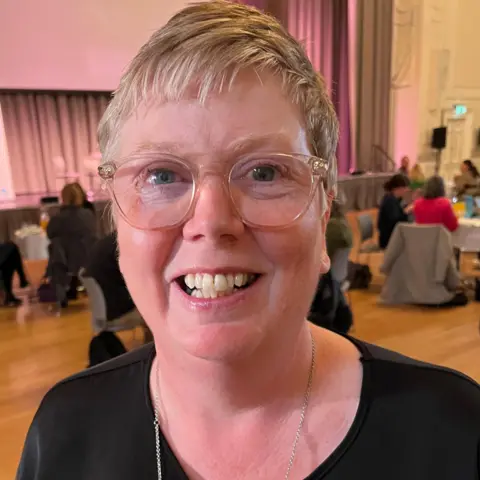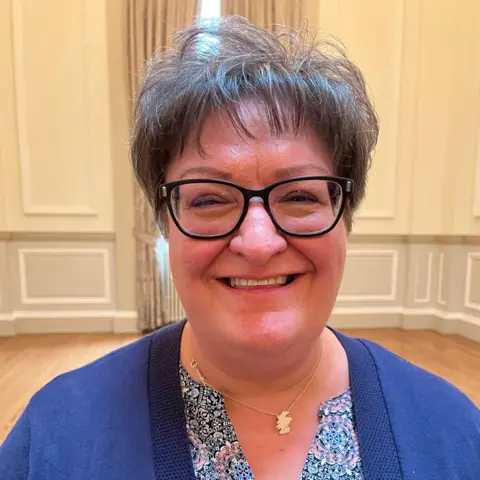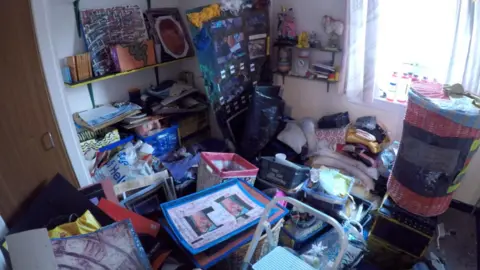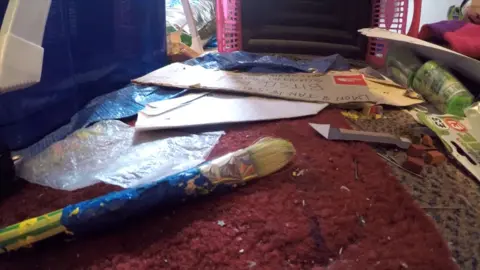'I'm a hoarder - it's my mess and it's who I am'
Dan MacNee stands among towering piles of boxes, papers, and creative projects that engulf his Edinburgh home.
Walls, doors, are covered with paintings, drawings and maps.
"It's grim," he says. "Things everywhere. It's overwhelming, and I've got other spaces just like this. The garage, the workshops, they're all full."
For Dan, this accumulation isn't just about objects - it represents his life journey.
"I've got a huge amount of stuff, and I'm always trying to order and organise it," he says. "The better I get it neat and tidy, the better I cope - not just with my disability, but also the mental illness and the abuse that underlies it."
Dan is a hoarder.
He attributes his condition to having moved over 50 times across three continents in 30 years. He says his sense of security has been repeatedly uprooted.
"When your sense of security keeps getting pulled out from under you, you hang on to things," he adds. "It's a vain attempt to establish some sense of security."
Despite acknowledging that his hoarding makes him "horribly uncomfortable", Dan finds it difficult to let go.
"It's my life, it's who I am. Even if it makes me uneasy, I can't just let it go."
Dan is among an estimated 1 in 40 adults under 55 who experience hoarding. For those over 55, it is roughly 6% of the population, although that may be a conservative estimate according to academics.
Hoarding is a condition that can be triggered by loss, trauma, or mental health issues. Hoarding disorder was officially recognised as a mental health condition in 2013 yet understanding and awareness is limited.

At a recent conference in Edinburgh, experts and professionals gather to discuss strategies for supporting people like Dan. Organised by the Hoarding Academy charity, the event called for a unified, nationwide approach to address hoarding in Scotland.
Linda Fay, expert and founder of the Academy, emphasises the urgency of collaboration.
"We've got people creating policies up and down the country, and it's a waste of resources," she says. "We need one set of multi-agency guidelines that we can all adhere to."
Comfort and security
Hoarding goes beyond mere clutter. It becomes a disorder when the accumulation of items disrupts daily living and when rooms can no longer serve their intended purpose.
"Belongings are there for a reason," Ms Fay says. "They give feelings of comfort, safety, security - whatever it may be. The clutter is just a symptom of what's going on with the individual."
She would never advocate clearing someone’s home without their agreement.
"I help people gradually reduce their belongings at their own pace, focusing on practical and therapeutic techniques to manage their space," she said.
Dr Christiana Bratiotis, an associate professor at the University of British Columbia, has dedicated years to studying hoarding.
At the Edinburgh conference she said: "Hoarding is an anxiety-based disorder.
"It's not a problem of laziness or lack of standards but a mental health condition."
Research into hoarding is relatively recent. "The research into hoarding is only about 40 years old," Dr Bratiotis points out. "Compared to other psychiatric illnesses like depression, which we've been studying for centuries, we have a long way to go."

Understanding hoarding requires delving into its psychological underpinnings. "We believe hoarding is a complex interplay of various factors," says Dr Bratiotis.
"Genetic vulnerabilities, strong emotions about objects, thoughts about the value of keeping things, and life events all contribute."

Statistics indicate that about 50% of people with hoarding disorder have experienced traumatic childhood events, and many also suffer from other mental health issues.
"Some studies suggest that 92% of those diagnosed with hoarding disorder have one or more other diagnosable mental health problems," she adds.
For those affected, the path to managing hoarding behaviour is difficult. Simply clearing out a person's home isn't a viable solution and can often worsen the situation.
"If you think about it, we all have prized possessions," says Dr Bratiotis.
"If someone removes items without the person's control or permission, it can be quite traumatic."

Both Ms Fay and Dr Bratiotis call for increased awareness and better resources. Tools like the Home Environment Assessment Tool for Hoarding (HEATH) have been developed to help providers like fire and housing services identify health and safety risks in the home.
"Accessibility to help is crucial," says Ms Fay. "Most people don't know that there are organisations that can work with people at home, providing practical and therapeutic support."
She also underscores the need for a national strategy. "We need some national guidelines," she adds. "We've set up a national hoarding task force."
For Dan, the journey isn't straightforward, but he hopes that sharing his story might encourage others to seek support. "Everyone's situation is different," he says.
"But if you can get support, take it, wherever it comes from. The problem is people think you can just clear it all out and that will solve everything. It doesn't work like that. Taking the stuff away doesn't take the emotional abuse away."
